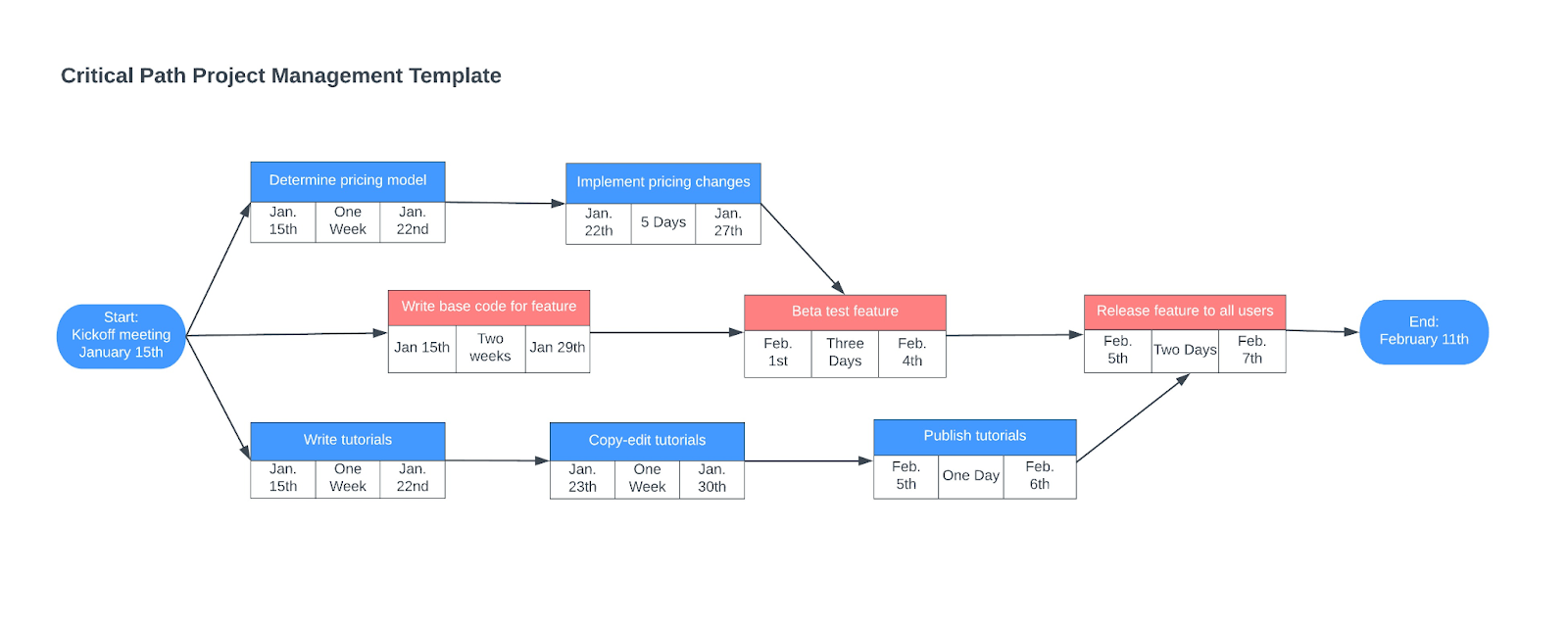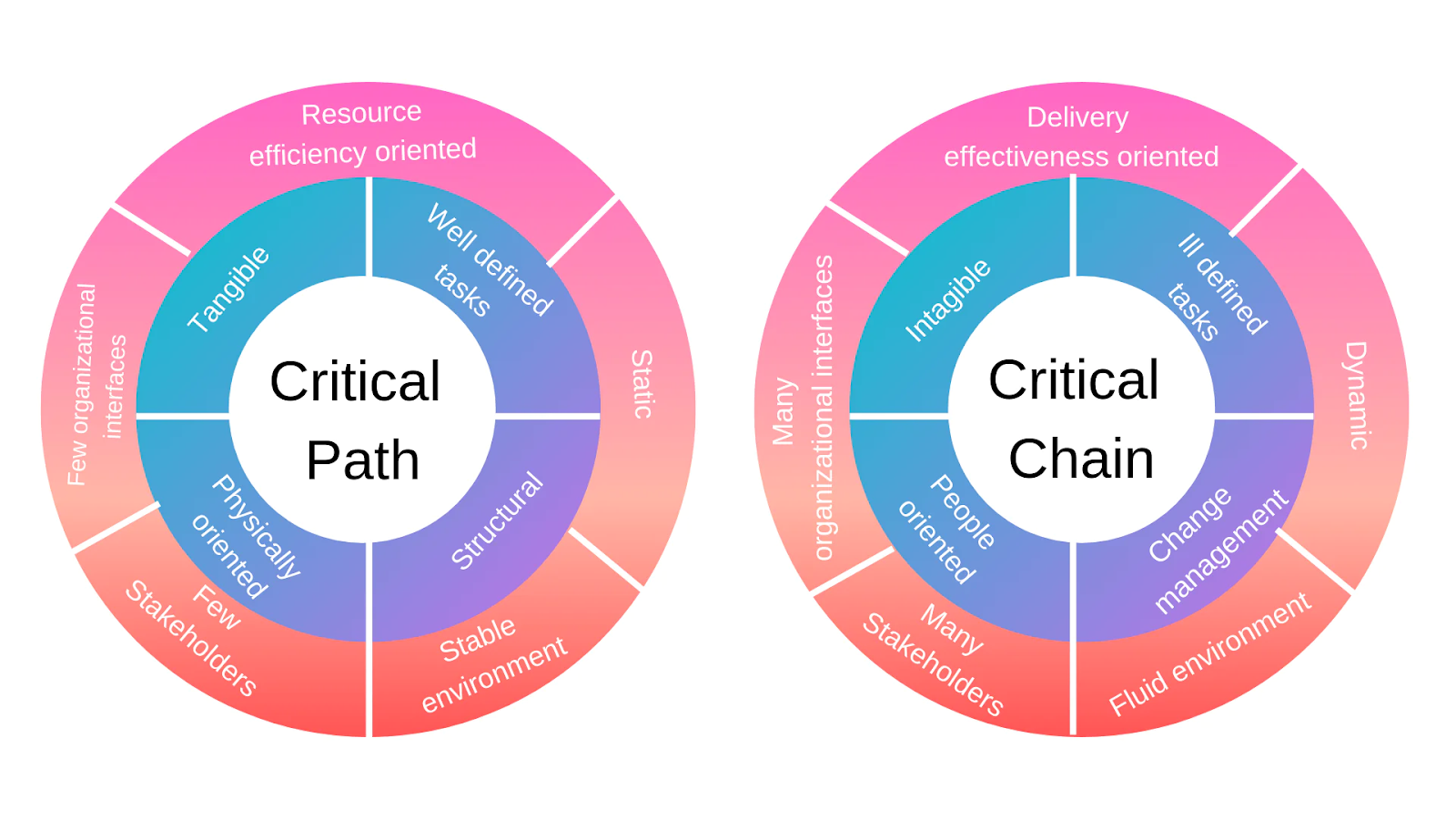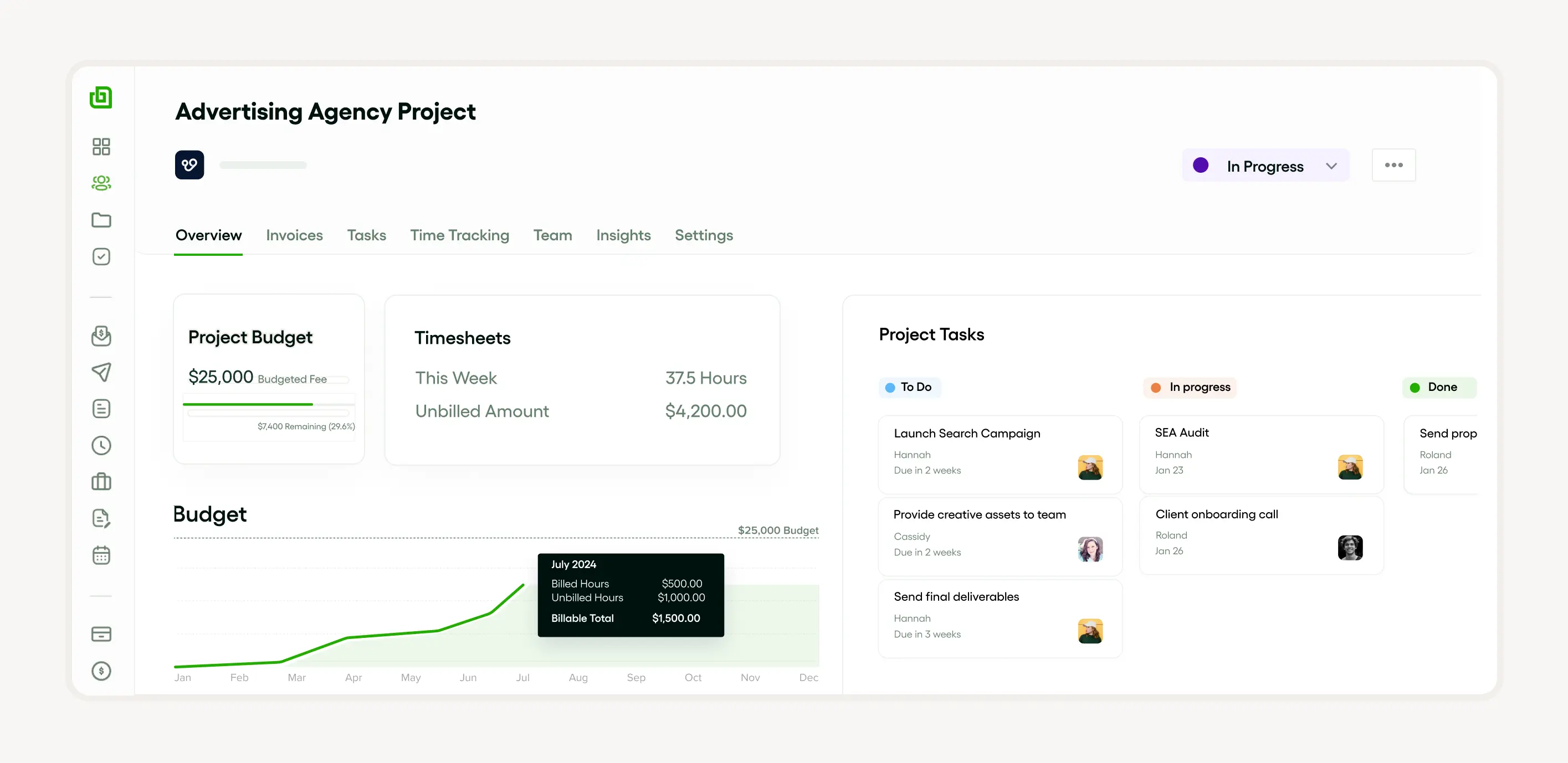The critical chain method in project management offers a practical approach to managing complex projects. It improves on the traditional critical path method by integrating concepts from the theory of constraints, with a particular focus on resource constraints and task dependencies.
Central to this method are project buffers, which protect the project schedule from unexpected delays, and resource buffers, which address issues related to resource availability. Additionally, this method emphasizes buffer management, often through resource leveling, to balance resource use and ensure timely project completion according to the project plan.
The work breakdown structure is vital in defining tasks and identifying the critical path. By identifying the critical chain—the longest path in the project network that considers both task and resource dependencies—project management becomes more efficient, increasing the likelihood of project success.
Introduction to critical chain method
The critical chain method (CCM) in project management emphasizes resource leveling and task dependencies to optimize the project schedule. Rooted in the theory of constraints, CCM prioritizes resource constraints over the traditional critical path method. The method involves using project and resource buffers to safeguard the project completion date against uncertainties.
With CCM, buffer management becomes integral to maintaining the project plan. The buffers absorb variations in task durations, facilitating smoother execution of the work breakdown structure, thereby maximizing project performance.

Definition of critical chain method
The critical chain method (CCM) is a project management technique that aligns resources with tasks, considering both task dependencies and resource constraints. It's a variant of the critical path method that focuses on using buffers to manage schedule and resource risks. This method employs the theory of constraints and resource leveling to ensure project completion within the project plan timeframe.
Key features of CCM include project buffers, which protect the project schedule against delays, and resource buffers, which ensure resources are available when needed. Buffer management plays a vital role in identifying the critical chain—the longest sequence of dependent tasks considering resource availability—within the work breakdown structure.
Origins and development of the critical chain method
The critical chain method (CCM) originated from the theory of constraints as a solution to address uncertainties and resource constraints in project management. Introduced by Eliyahu M. Goldratt in the 1990s, CCM transformed the traditional critical path method by adding project and resource buffers to handle uncertainties and improve project completion. Key aspects of CCM include task dependencies, buffer management, and resource leveling to optimize the project schedule and enhance the effectiveness of the project plan.
Plan your critical chain with a project management tool Bonsai
Are you ready to elevate your project management skills? Let’s explore how you can effectively plan your critical chain with Bonsai, an incredibly useful project management tool. Whether you’re managing several tasks at once or ensuring your team stays on schedule, Bonsai is here to help. We’ll guide you through identifying key tasks, allocating resources, and tracking progress to make sure your project stays on track and meets all its deadlines. Let’s jump in!
Planning your critical chain with Bonsai, a project management tool, can significantly enhance your project's efficiency and success.
Here are the steps to effectively plan your critical chain using Bonsai:
1. Identify critical tasks and dependencies
Start by pinpointing all the tasks necessary for your project’s completion. Use Bonsai's task management tools to compile this list and clarify their dependencies. Critical tasks are those that have a direct effect on the project's finish date.
In Bonsai, you can visually map out these tasks and their relationships using Gantt charts or network diagrams. This visualization aids in grasping the order of activities and recognizing the critical path, which is vital for the Critical Chain Method (CCM).

2. Allocate resources and set buffers
After identifying the critical tasks, the next step is to allocate resources effectively. Bonsai enables you to assign resources to each task, ensuring that the right individuals are engaged in the appropriate tasks at the correct times. It’s important to consider resource availability to prevent overburdening any team member.

Additionally, establish buffers to safeguard the critical chain against uncertainties. Bonsai's real-time tracking and resource management capabilities assist in overseeing resource allocation and adjusting buffers as necessary. This approach ensures that delays in non-critical tasks do not disrupt the overall project timeline.
3. Monitor progress and adjust plans
Ongoing monitoring and adjustments are essential for effective project management. Bonsai offers real-time progress tracking and reporting tools that help you stay updated on the project's status. Regularly assess the progress of critical tasks and the use of buffers.
If challenges arise, such as delays or resource limitations, leverage Bonsai's adaptable planning features to implement necessary changes. This may involve reallocating resources, shifting task priorities, or modifying buffers. By remaining proactive and adaptable, you can keep your project on course and ensure it meets its deadlines.
Bonsai improves the use of the Critical Chain Method by offering strong tools for managing tasks, allocating resources, and tracking progress.
Understanding the principles of critical chain method
The critical chain method (CCM) is a project management process grounded in the principles of the theory of constraints. It primarily focuses on resource constraints and task dependencies, differing from the traditional critical path method (CPM), which emphasizes task durations and project schedules.
CCM introduces the concepts of project and resource buffers for buffer management. These time buffers protect project completion dates from uncertainties, offering a more realistic project plan and mitigating the impact of variations.
Through techniques such as resource leveling and the work breakdown structure, CCM provides a strategic approach to achieving project completion within the planned scope, cost, and time.
Focus on resources
One key tool in project management is the critical path method, which relies heavily on task dependencies to calculate the shortest project completion time. Another important element in managing resources is buffer management, significantly involving project and resource buffers. These buffers address uncertainties and ensure smooth operations despite possible resource constraints.
Consideration of the theory of constraints helps acknowledge potential bottlenecks or resource limitations in the project plan. Methods such as resource leveling are employed to address these in relation to the project schedule and the work breakdown structure of tasks, emphasizing efficient resource use.
Project buffering
Project buffering is a key aspect of project management. It involves using the theory of constraints to address task dependencies and resource constraints by implementing suitable project buffers. This process utilizes the critical path method and buffer management to ensure flexibility in the project schedule.
Creating project buffers involves strategically placing resource buffers on the critical path in the project plan. Parameters like the work breakdown structure and resource leveling play a significant role in project completion. Effective project buffering can help mitigate potential risks and unforeseen delays.
Elimination of bad multitasking
To enhance project management, eliminating bad multitasking is critical. This starts with a well-structured project plan that outlines the work breakdown structure, allowing for an understanding of task dependencies. This can then be used to draw up a project schedule using strategies such as the critical path method and the theory of constraints.
Further, resource constraints can be handled by implementing resource leveling processes, and buffer management techniques such as project and resource buffers can be employed to safeguard against unforeseen delays or issues, ultimately supporting project completion.

Benefits of using the critical chain method
One main benefit of using the critical chain method (CCM) is its inherent focus on resource constraints and task dependencies, which improves project management by alleviating bottlenecks and enhancing resource utilization. It counteracts the extreme timelines often seen in the traditional critical path method, leading to a more realistic project plan and schedule.
Another key advantage of CCM is the use of both project and resource buffers. This buffer management strategy ensures timely project completion by absorbing uncertainties in project tasks.
Lastly, CCM aligns with the theory of constraints, offering a work breakdown structure that emphasizes the critical path, resulting in efficient resource leveling.
Improved project efficiency
Effective project management incorporates elements such as the critical path method, the theory of constraints, and task dependencies to increase project efficiency. The critical path method helps estimate the project schedule accurately, while the theory of constraints identifies the most significant limiting factors. Task dependencies determine the order in which tasks should be executed, ensuring a well-structured work breakdown structure.
Moreover, efficient buffer management, involving project and resource buffers, aids in handling unexpected changes. Resource constraints can be managed through resource leveling, eventually leading to successful project completion.
Reduced project duration
Effective project management can ensure reduced project duration. This can be achieved through the theory of constraints, which helps identify and manage bottlenecks in a project plan. Additionally, project buffers protect project completion dates from unforeseen delays.
Applying the critical path method, which determines important task dependencies and helps prioritize tasks on the critical path, also contributes to shorter project durations. Lastly, resource leveling is essential for managing resource constraints and can be further improved by buffer management.
Enhanced resource utilization
Enhancing resource utilization is a key aspect of project management. Techniques such as the critical path method and the theory of constraints enable effective analysis of task dependencies, optimizing the project schedule and ensuring efficient resource leveling. Project buffers are integrated into the project plan to manage potential changes and delays, increasing the likelihood of successful project completion.
Buffer management plays a significant role in managing resource buffers and resource constraints. This includes a comprehensive view of the work breakdown structure, ensuring that resources are used in the most efficient manner. This approach is vital for achieving the pre-specified project objectives on schedule and within budget.
Comparing critical chain method with other project management techniques
The Critical Chain Method (CCM) embraces the theory of constraints and buffer management to tackle resource constraints and task dependencies. Unlike the Critical Path Method (CPM) which focuses on the project schedule and work breakdown structure, CCM prioritizes resource leveling and the utilization of project buffers for ensuring timely project completion.
Moreover, CCM uses shorter individual task durations, which typically result in shorter overall timelines compared to other techniques. This method also introduces more flexibility through the inclusion of project and resource buffers, enhancing adaptability to project changes and providing a higher certainty of completion within set timeframes.
Critical chain method vs. critical path method
Both the Critical Path Method (CPM) and the Critical Chain Method (CCM) are fundamental approaches in project management. CPM is mainly concerned with task dependencies and scheduling, aiming to identify the critical path in a project schedule that affects completion time.
Conversely, CCM, arising from the Theory of Constraints, emphasizes resource constraints and buffer management. It includes project buffers and resource buffers to manage uncertainties, facilitating resource leveling for smooth execution of the project plan. Both methods rely on a detailed work breakdown structure and require comprehensive project management for success.
Critical chain method vs. Agile project management
The Critical Chain Method integrates various project management concepts like the theory of constraints, critical path method, and task dependencies. It focuses on managing resource constraints and buffer management, using project buffers and resource buffers for effective project completion. The project schedule heavily leans on the critical path and work breakdown structure. In contrast, Agile Project Management is more flexible and adaptive, emphasizing iterative progress and continuous user feedback. Agile does not focus on resource leveling or precise project plans as CCM does. Each iteration sets its own project completion expectations, adapting the project management approach based on achieved results.
Implementing the critical chain method in your agency
Adopting the Critical Chain Method in your agency can effectively address resource constraints and manage project buffers. This technique, based on the Theory of Constraints, complements the Critical Path Method for efficient project management.
Changes in the project schedule and task dependencies are managed through strategic buffer placement, ensuring project success. Steps to incorporate include defining the project plan and work breakdown structure, identifying the critical path, employing resource leveling techniques, and emphasizing buffer management to maintain project pace and meet deadlines.

Steps to implement the critical chain method
Initiating the Critical Chain Method starts with creating a detailed work breakdown structure that explains task dependencies within the project. Then, applying the critical path method develops the project schedule, helping to identify the critical path and resource constraints.
Introducing buffers into your project plan, including project buffers for unforeseen delays, and resource buffers for resource availability issues, is vital. Agility in buffer management is crucial for handling changes during project execution.
To ensure optimal resource utilization and avoid bottlenecks, proactive resource leveling is necessary, contributing significantly to effective project management and achieving planned project completion.
Challenges in implementing the critical chain method
Adopting the Critical Chain Method presents several challenges like managing task dependencies, project buffers, and resource constraints. Shifting from traditional project management methods like the critical path method requires a change in focus towards achieving project completion based on buffer management rather than adhering strictly to a project schedule.
The theory of constraints, which underlies this method, requires ongoing attention to identifying and resolving bottlenecks, adding complexity to the project plan. Moreover, ensuring resource leveling without extending the work breakdown structure can be challenging.
Real-world examples of critical chain method application
Industries with high complexity and task dependencies, like aerospace, often employ the Critical Chain Method in project management. For instance, constructing a spacecraft involves an extensive work breakdown structure, with the critical path method and theory of constraints guiding the project plan. In construction projects, resource constraints such as labor or material scarcity can significantly affect the project schedule.
Applying buffer management, using project buffers and resource buffers, ensures smooth project completion through resource leveling. The IT sector also implements the Critical Chain Method in software development projects, managing project buffers against timeline uncertainties and mitigating risks related to resource constraints.
Application of critical chain method in construction projects
The Critical Chain Method proves highly effective in construction project management, especially in managing task dependencies and the project schedule. This approach integrates the theory of constraints and the critical path method with buffer management. Setting up resource buffers and project buffers accommodates resource constraints and unforeseen delays, ensuring the project's completion aligns with the planned timeline.
Additionally, CCM supports a thoughtful work breakdown structure and effective resource leveling, boosting the efficiency and effectiveness of the overall project plan.
Application of critical chain method in IT projects
In IT project management, the Critical Chain Method, leveraging the theory of constraints, stands apart from the traditional critical path method by incorporating project and resource buffers to manage uncertainties and resource constraints. Key steps of this approach include developing a work breakdown structure, establishing task dependencies, and a comprehensive project schedule.
Resource leveling follows, with the addition of project and resource buffers, providing a contingency for potential risks or delays, enhancing the predictability and success rate of IT projects.
Software tools to support the critical chain method
Advanced tools that specifically support the Critical Chain Method are crucial for effective project management. These tools address key elements such as resource constraints, task dependencies, and the theory of constraints. They assist in managing the project schedule, creating a work breakdown structure, and ensuring optimal buffer management with project and resource buffers.
Some tools offer functionalities for resource leveling to balance resource distribution across the project, crucial for timely project completion. They also help outline the critical path method, allowing project managers to identify the longest task path in the project plan, enabling more efficient project execution.
Bonsai
Bonsai Software is a flexible project management tool that effectively supports the Critical Chain Method (CCM). This approach emphasizes optimizing resources and prioritizing tasks to ensure projects are completed on time. Bonsai Software helps identify critical tasks and resource limitations, enabling project managers to allocate resources effectively and prevent bottlenecks.

The tool offers features like task scheduling, real-time progress tracking, and resource management, which are important for applying CCM. By visualizing task dependencies and potential delays, Bonsai assists teams in staying on course and meeting deadlines.
Moreover, its user-friendly interface and customizable dashboards make it simple to monitor project health and make well-informed decisions.
In short, Bonsai Software improves the use of the Critical Chain Method by streamlining project workflows, enhancing resource utilization, and ensuring that projects are finished on schedule and within budget.
Prochain project scheduling
ProChain Project Scheduling employs the critical path method, theory of constraints, and task dependencies to optimize project management. This strategy includes various elements such as project buffers, resource buffers, and buffer management techniques to ensure smooth project completion. It considers resource constraints and uses resource leveling to overcome them.
ProChain project scheduling creates a detailed work breakdown structure that forms part of the comprehensive project plan, enabling effective tracking and management of the project schedule from start to finish.
Microsoft project
Microsoft Project is a powerful tool that aids in project management by creating project schedules, a work breakdown structure, and customizing task dependencies. It employs the critical path method, highlighting the sequence of tasks that directly impact the project completion time.
Furthermore, Microsoft Project uses the theory of constraints to mitigate resource constraints and ensure resource leveling. The software also integrates buffer management strategies including the use of project buffers and resource buffers. These protect the project plan and provide flexibility, enhancing its success likelihood. Thus, Microsoft Project is a comprehensive tool for efficient project management.
Conclusion: Is the critical chain method right for your agency?
In conclusion, the Critical Chain Method could be a great fit for your agency if dealing with task dependencies, managing resource constraints, and staying within the project schedule are key elements for the successful completion of your projects. This approach, founded on the theory of constraints, emphasizes resource buffers and project buffers, enhancing buffer management, and ensuring a more efficient project plan.
So, if you're looking to improve your project management strategies, especially concerning work breakdown structure and resource leveling, CCM could be worth a shot.







